

Edward S. Curtis collection. Welcome Home! - Curating Primary Sources - LibGuides at University of South Dakota. 10 Resources for Teaching With Primary Sources - Best of 2015-16 School Year. All of this week I am on the road working with teachers in Texas, Kansas, and Arizona.
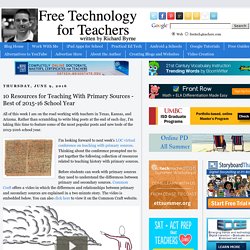
Schoollibrarianmindset. DocsTeach. Curation: Creatively Filtering Content. We are living in an era of information overload.
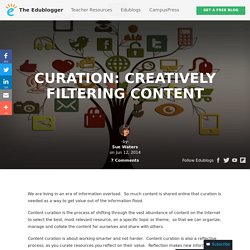
So much content is shared online that curation is needed as a way to get value out of the information flood. Content curation is the process of shifting through the vast abundance of content on the Internet to select the best, most relevant resource, on a specific topic or theme, so that we can organize, manage and collate the content for ourselves and share with others. Content curation is about working smarter and not harder. Content curation is also a reflective process; as you curate resources you reflect on their value. Reflection makes new information stick in your brain. Video: South Dakota Icons. 15 Tools for Teaching History With Technology - A Handout. One of the things that teachers often ask me for is a set of tools to get them started on using technology in their classrooms.
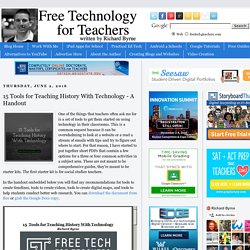
This is a common request because it can be overwhelming to look at a website or a read a stream of emails with tips and try to figure out where to start. For that reason, I have started to put together short PDFs that contain a few options for a three or four common activities in a subject area. These are not meant to be comprehensive guides, they're meant to be starter kits. The first starter kit is for social studies teachers. Teachingprimarysources - home. Getting Started with Primary Source Research for Teachers and Students. Research, Share and Collaborate with Diigo. History Day Research In Minnesota.
The Uncommon Corps: Connecting to Social Studies Curriculum Through Text-Sets: A Sensible Shift. I have long believed that Common Core discussions need to shift from talk about content-free standards to talk about content-rich curriculum that embeds standards.
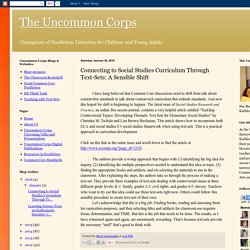
And now this hoped for shift is beginning to happen. The latest issue of Social Studies Research and Practice, an online free-access journal, contains a very helpful article entitled “Tackling Controversial Topics: Developing Thematic Text Sets for Elementary Social Studies” by Christina M. Tschida and Lisa Brown Buchanan. This article shows how to incorporate both ELA and social studies C3 social studies framework when using text-sets. This is a practical approach to curriculum development. The authors provide a 4-step approach that begins with (1) identifying the big idea for inquiry, (2) identifying the multiple perspectives needed to understand this idea or topic, (3) finding the appropriate books and artifacts, and (4) selecting the materials to use in the classroom.
Let’s acknowledge that this is a big job. Four Virtual Field Trips That Will Broaden Horizons. By Billy Krakower, Jerry Blumengarten, and Paula Naugle No funding for field trips?

Concerns about travel safety? Consider taking your students on a virtual adventure instead. The Uncommon Corps: Examining Historical Photographs with Your Head and Your Heart. Reading Dorothea’s Eyes, a picture book biography by Barb Rosenstock, reminded me of how emotional response seems to have dropped out of the conversation about reading.
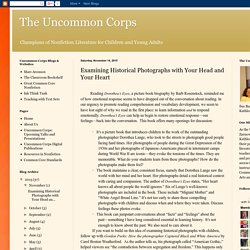
In our urgency to promote reading comprehension and vocabulary development, we seem to have lost sight of why we read in the first place: to learn information and to respond emotionally. Dorothea’s Eyes can help us begin to restore emotional response—our feelings—back into the conversation. Primary Sources: From the Library of Congress & More to Your Classroom. Igniting a Passion for History with Chronicling America. "Daily Missourian" headline from 1917, courtesy of Chronicling America So many of our students arrive with a negative impression of the discipline of history.
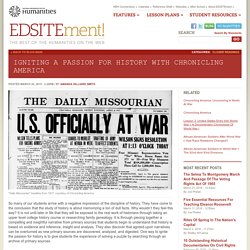
They have come to the conclusion that the study of history is about memorizing a ton of dull facts. Why wouldn’t they feel this way? It is not until later in life that they will be exposed to the real work of historians through taking an upper level college history course or researching family genealogy. History Unfolded: US Newspapers and the Holocaust. A Great Explanation of Primary Sources vs. Secondary Sources. OER and you. The curation mandate. At the #GoOpen Exchange on Friday, everyone was talking about OER and the need to curate.

The Twiter feed shows the buzz around the trending event and it shows school librarians were at the table. As the initiative moves forward, it is critical for us to choose to be at the head of this particular table. Hosted at the beautiful Skywalker Ranch, Friday’s #GoOpen Exchange engaged major players in education from the White House and the DOE, as well as state officials, leaders of non-profits and learning institutions, the biggest names in e-commerce and technology, developers, vendors, publishers, state officials, administrators, leading folks in edtech, and educational thinkers and practitioners.
I was proud to be there to share along with some serious library power: AASL President Leslie Preddy, Mark Ray (WA) Washington, Jennifer Boudrye (D.C.) and Mary Reiman (NE). But it was clear to our little group, that to the larger majority of the participants, we were not even on the OER radar. Primary Sources for your Classroom - Ellis Island Part of Statue of Liberty National Monument. Primary sources are powerful tools to help bring history alive for students.
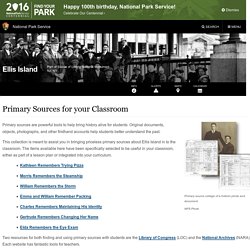
Original documents, objects, photographs, and other firsthand accounts help students better understand the past. This collection is meant to assist you in bringing priceless primary sources about Ellis Island in to the classroom. The items available here have been specifically selected to be useful in your classroom, either as part of a lesson plan or integrated into your curriculum. Kid-created exhibits that teach. What is a Primary Source? by Shmoop. History Detectives. Lesson: Primary SourcesGrades: 6-12Subject: Language Arts/Social Studies/TechnologyEstimated Time of Completion: Four to five 50-minute class sessions I.
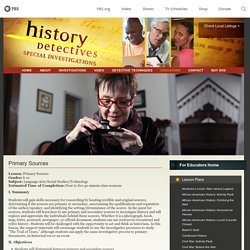
Summary Students will gain skills necessary for researching by locating credible and original sources, determining if the sources are primary or secondary, ascertaining the qualifications and reputation of the author/speaker, and identifying the setting/circumstance of the source. In the quest for sources, students will learn how to use primary and secondary sources to investigate history and will explore and appreciate the individuals behind these sources. Whether it is a photograph, book, map, letter, postcard, newspaper, or official document, students can use sources to reconstruct and relive history.
II. III. IV. 1. 2. 3. 4. 5. 6. Primary vs. Secondary Sources. College, Career, and Civic Life (C3) Framework for Social Studies State Standards. USGS Historical Topographic Map Explorer. Augustana Research Repository (ARR) is transitioning to .np3. More Than 100 Sets of Primary Source Documents for Students. A few years ago I wrote a post about searching through the Digital Public Library of America to locate primary source documents to use with students. At that point the DPLA had relatively few, loosely organized collections. Yesterday, I received an email from DPLA informing me that they now have more than 100 primary source document sets for students. The DPLA's primary source document sets are organized by subject and time period in United States history.
Depending upon the time period the DPLA primary source sets include documents, drawings, maps, photographs, and film clips. WhatWasThere - Put history in its place! Reading Like A Historian History Curriculum. Understanding Primary and Secondary Sources. Use Thematic Text Sets to Spark "Unstoppable Learning" By Katie and Chris Cunningham When we think about the middle school experience of today, we often ask ourselves…what matters most? Primary Sources in the Classroom. ALA 140th Photos. Primarily Speaking: Tips and Tricks for Integrating Primary Documents into Teaching & Learning.
Presented by Connie Williams, National Board Certified Teacher Librarian for Petaluma High School Sponsored by Libraries Unlimited and ABC-CLIO Solutions Come and experience primary documents as tools for inquiry, project based learning, and critical thinking lessons. In this webinar, teacher-librarian, NBCT, and past President of CSLA, Connie Williams, led an interactive session on several different strategies for teaching with and teaching about primary documents.
Connie shared ways to help students think critically about primary documents in a variety of content areas. Photogrammar Photo Archive From Yale - Search Through Great Depression Era Photos. Theodor Jung/Courtesy of Yale If you've ever wondered what your little slice of the world looked like decades ago, we've got a rabbit hole for you to fall down: Yale University has collected 170,000 photos from the Library of Congress that were taken between 1935 and 1945 — the Depression era. The government archive of snaps from this period is quite large. Since the administration wanted to build support for programs like the New Deal, they sent photographers all over the United States to document the state of the country. Teachers' Resources. Native Americans. American Archive: A new online “reading room” of historical public media. PrimarySourceSets. Librarydoor: Got Primary Source "Sets" from LOC?
10 Resources for Teaching With Primary Sources. I'm looking forward to next week's LOC virtual conference on teaching with primary sources. Teacher Resources - Library of Congress. There's more to every story.